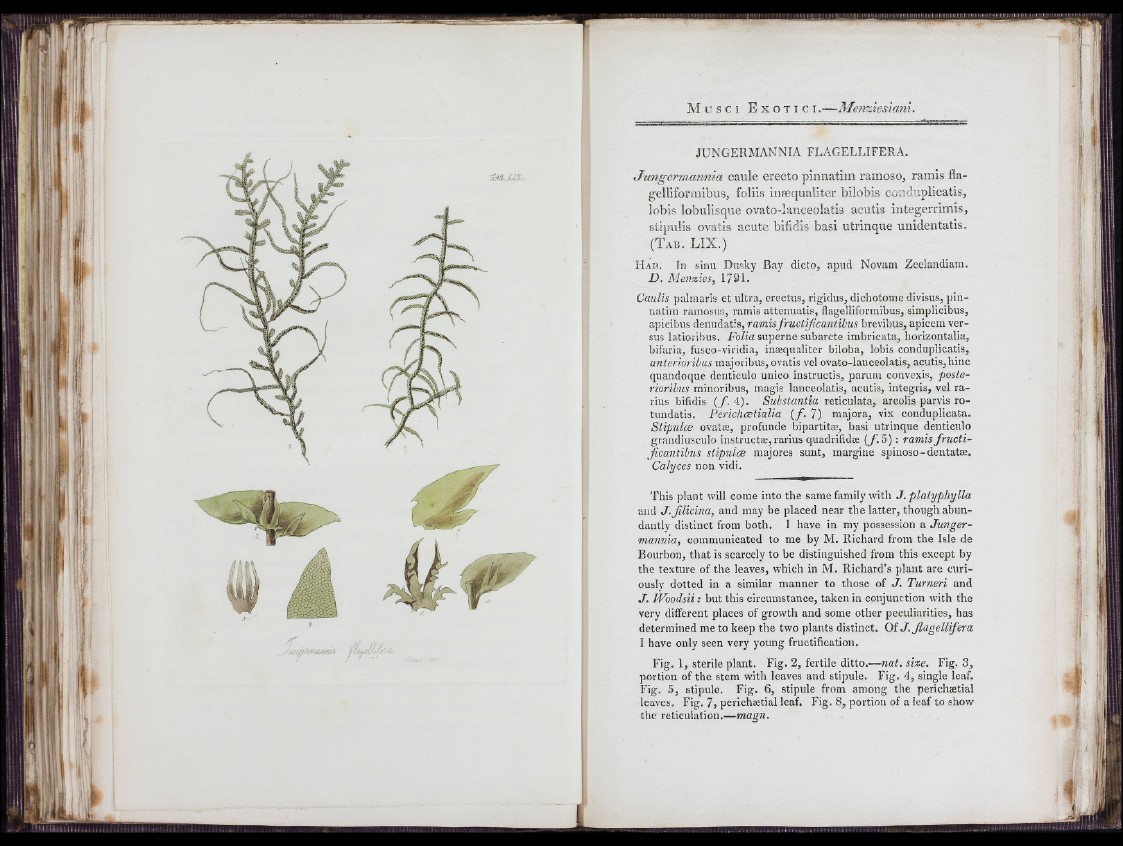
¿5! j
7M.JÌÌX,
f - , 7
JUNGERMANNIA FLAGELLIFERA.
Jungermannia caule erecto pinnatim ramoso, ramis fla-
gelliformibus, foliis inæqualiter bilobis conduplicatis,
lobis lobulisque ovato-lanceolatis acutis integerrimis,
stipulis ovatis acute bifidis basi utrinque unidentatis.
( T a b . LIX.)
H a b . In sinu Dusky Bay dicto, apud Novam Zeelandiam.
f l . Menzies, 1791.
Caulis palmaris et ultra, erectus, rigidus, dichotome divisus, pinnatim
ramosus, ramis attenuatis, flageliiformibus, simpiicibus,
apicibus denudatis, ramisfructificantilus brevibus, apicem versus
latioribus. Folia superne subarcte imbricata, horizontalia,
bifaria, fusco-viridia, inæqualiter biloba, lobis conduplicatis,
anterioribus majoribus, ovatis vel ovato-lanceolatis, acutis,hinc
quandoque dentículo unico instructis, parurri convexis, posterioribus
minoribus, magis lanceolatis, acutis, integris, vel rarius
bifidis ( f . 4). Substantia reticulata, areolis parvis ro-
tuiidatis. Ferichætialia ( / . 7) majora, vix conduplicata.
Stipuloe ovatæ, profonde bipartitæ, basi utrinque denticulo
graiidiusculo instructæ, rarius quadrifidæ ( / i 5) : ramis fr u c ti-
Jicantibus stipuloe majores sunt, margine spinoso-dentatæ.
Calyces non vidi.
This plant will come into the same family with J. platyphylla
and J.JHicina, and may be placed near the latter, though abundantly
distinct from both. I have in my possession a Jungermannia,
communicated to me by M. Richard from the Isle de
Bourbon, that is scarcely to be distinguished from this except by
the texture of the leaves, which in M. Richard’s plant are curiously
dotted in a similar manner to those of J . Turneri and
J . Woodsii ; but this circumstance, taken iu conjunction with the
very different places of growth and some other peculiarities, has
determined me to keep the two plants distinct. Of J . Jlagellifera
I have only seen very young fructification.
Fig. 1, sterile plant. Fig. 2, fertile ditto.—nat. size. Fig. 3,
portion of the stem with leaves and stipule. Fig. 4, single leaf.
Fig. 5, stipule. Fig. 6, stipule from among the perichaetial
leaves. Fig. 7, perichætial leaf. Fig. 8, portion of a leaf to show
the reticulation.—magn.
>}’
IS'
R i i
!
■•a-
: ii || I
' r ifl
Si.
1 i-1
I ?
‘ i